Reward Management Report: Morrison's, RMT Module, Semester 1
VerifiedAdded on 2023/01/11
|18
|6023
|84
Report
AI Summary
This report provides a comprehensive analysis of reward management strategies, focusing on the case study of Morrison's supermarket chain. It begins by assessing the context of the reward environment, utilizing SWOT and PESTLE analyses to identify internal and external factors influencing reward decisions. The report then delves into the impact of business drivers such as affordability, market position, and economic outlook on reward policies. It provides examples of gathering and presenting reward intelligence through salary surveys, consultant reports, and market analyses. The core of the report examines key reward principles, including total rewards, equity, fairness, and transparency, and evaluates their contribution to employee performance and organizational success. It explores the implementation of reward policies and practices within Morrison's, and concludes by examining the role of line managers in reward decision-making, highlighting their contributions to employee motivation and engagement. The report integrates theoretical concepts with practical examples to offer a holistic view of effective reward management.
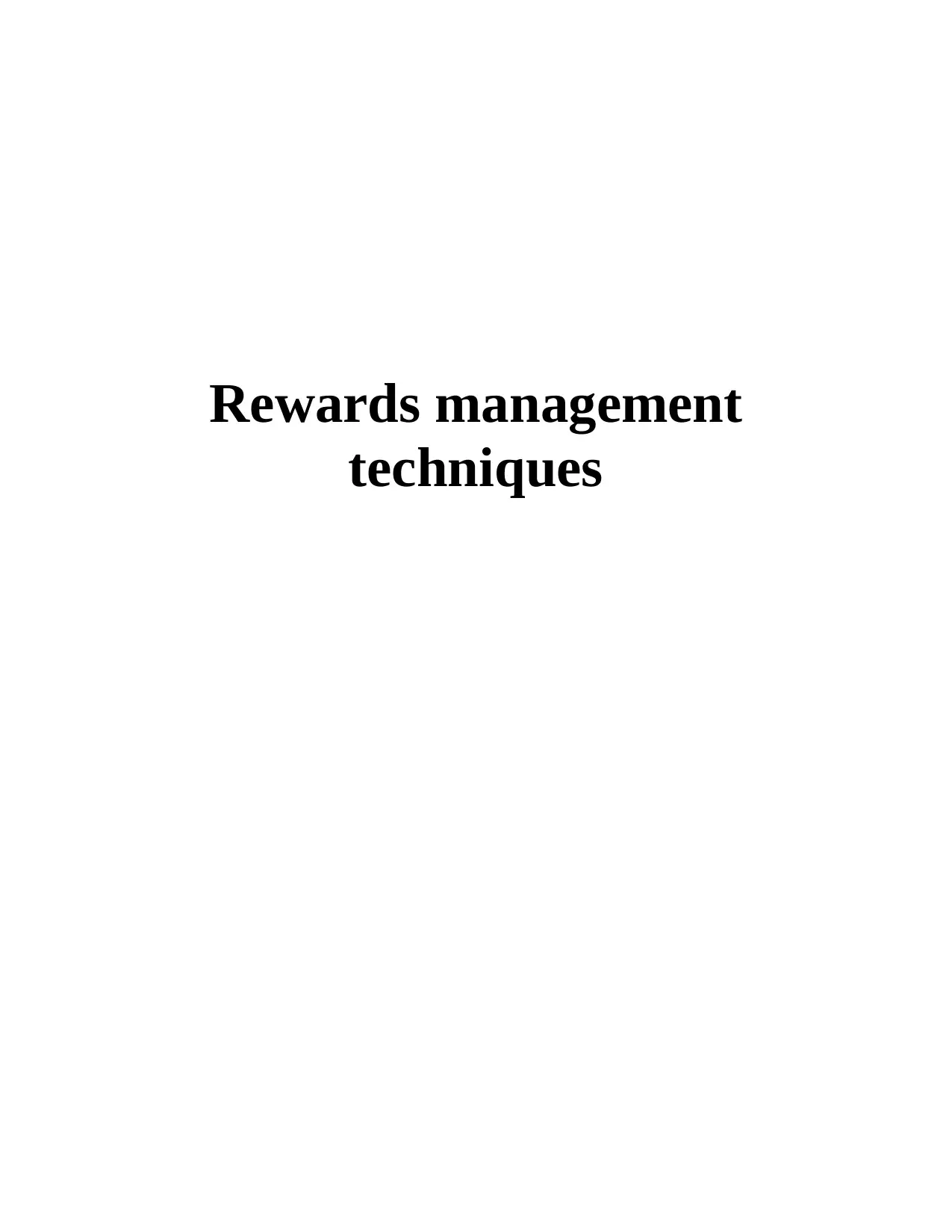
Rewards management
techniques
techniques
Paraphrase This Document
Need a fresh take? Get an instant paraphrase of this document with our AI Paraphraser
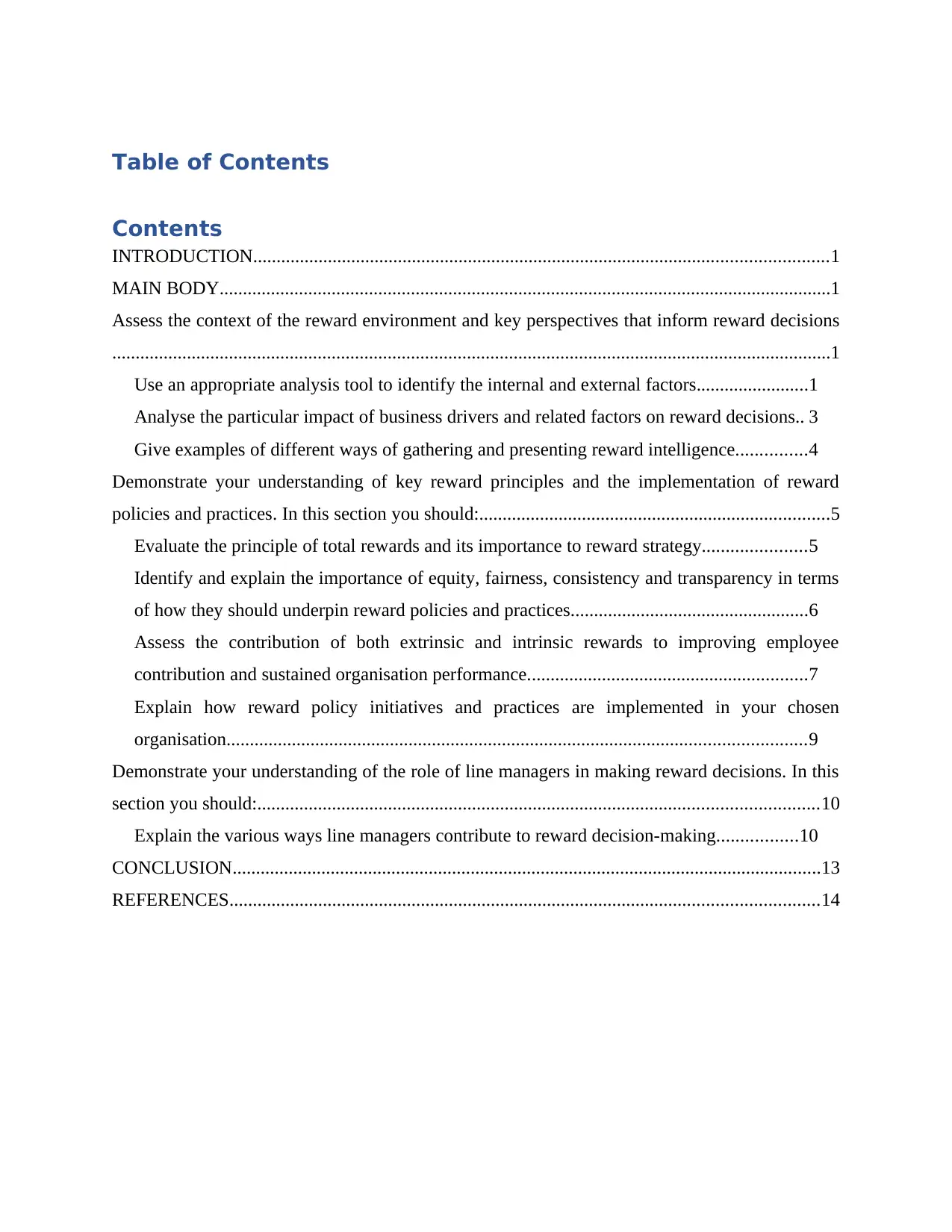
Table of Contents
Contents
INTRODUCTION...........................................................................................................................1
MAIN BODY...................................................................................................................................1
Assess the context of the reward environment and key perspectives that inform reward decisions
..........................................................................................................................................................1
Use an appropriate analysis tool to identify the internal and external factors........................1
Analyse the particular impact of business drivers and related factors on reward decisions.. 3
Give examples of different ways of gathering and presenting reward intelligence...............4
Demonstrate your understanding of key reward principles and the implementation of reward
policies and practices. In this section you should:...........................................................................5
Evaluate the principle of total rewards and its importance to reward strategy......................5
Identify and explain the importance of equity, fairness, consistency and transparency in terms
of how they should underpin reward policies and practices...................................................6
Assess the contribution of both extrinsic and intrinsic rewards to improving employee
contribution and sustained organisation performance............................................................7
Explain how reward policy initiatives and practices are implemented in your chosen
organisation............................................................................................................................9
Demonstrate your understanding of the role of line managers in making reward decisions. In this
section you should:........................................................................................................................10
Explain the various ways line managers contribute to reward decision-making.................10
CONCLUSION..............................................................................................................................13
REFERENCES..............................................................................................................................14
Contents
INTRODUCTION...........................................................................................................................1
MAIN BODY...................................................................................................................................1
Assess the context of the reward environment and key perspectives that inform reward decisions
..........................................................................................................................................................1
Use an appropriate analysis tool to identify the internal and external factors........................1
Analyse the particular impact of business drivers and related factors on reward decisions.. 3
Give examples of different ways of gathering and presenting reward intelligence...............4
Demonstrate your understanding of key reward principles and the implementation of reward
policies and practices. In this section you should:...........................................................................5
Evaluate the principle of total rewards and its importance to reward strategy......................5
Identify and explain the importance of equity, fairness, consistency and transparency in terms
of how they should underpin reward policies and practices...................................................6
Assess the contribution of both extrinsic and intrinsic rewards to improving employee
contribution and sustained organisation performance............................................................7
Explain how reward policy initiatives and practices are implemented in your chosen
organisation............................................................................................................................9
Demonstrate your understanding of the role of line managers in making reward decisions. In this
section you should:........................................................................................................................10
Explain the various ways line managers contribute to reward decision-making.................10
CONCLUSION..............................................................................................................................13
REFERENCES..............................................................................................................................14
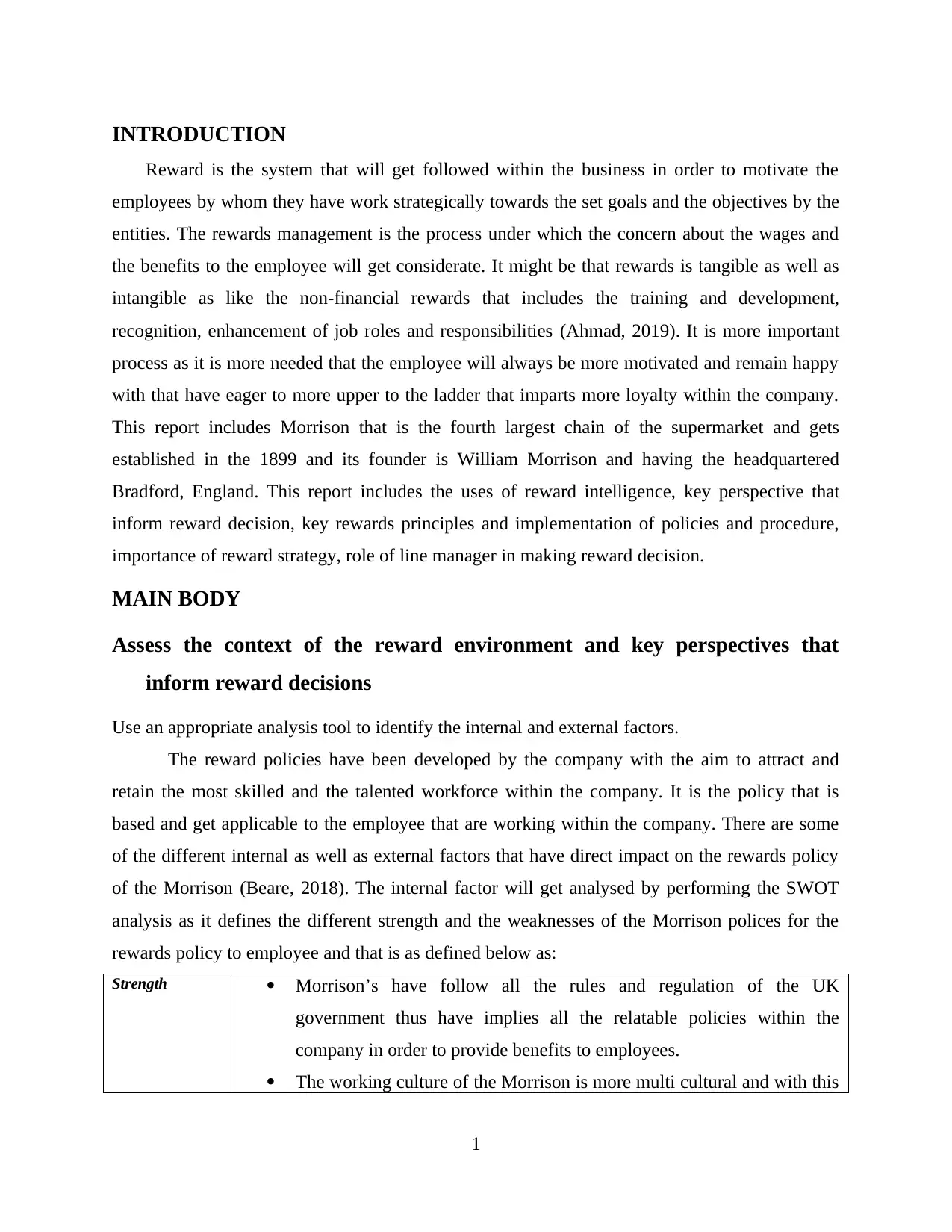
INTRODUCTION
Reward is the system that will get followed within the business in order to motivate the
employees by whom they have work strategically towards the set goals and the objectives by the
entities. The rewards management is the process under which the concern about the wages and
the benefits to the employee will get considerate. It might be that rewards is tangible as well as
intangible as like the non-financial rewards that includes the training and development,
recognition, enhancement of job roles and responsibilities (Ahmad, 2019). It is more important
process as it is more needed that the employee will always be more motivated and remain happy
with that have eager to more upper to the ladder that imparts more loyalty within the company.
This report includes Morrison that is the fourth largest chain of the supermarket and gets
established in the 1899 and its founder is William Morrison and having the headquartered
Bradford, England. This report includes the uses of reward intelligence, key perspective that
inform reward decision, key rewards principles and implementation of policies and procedure,
importance of reward strategy, role of line manager in making reward decision.
MAIN BODY
Assess the context of the reward environment and key perspectives that
inform reward decisions
Use an appropriate analysis tool to identify the internal and external factors.
The reward policies have been developed by the company with the aim to attract and
retain the most skilled and the talented workforce within the company. It is the policy that is
based and get applicable to the employee that are working within the company. There are some
of the different internal as well as external factors that have direct impact on the rewards policy
of the Morrison (Beare, 2018). The internal factor will get analysed by performing the SWOT
analysis as it defines the different strength and the weaknesses of the Morrison polices for the
rewards policy to employee and that is as defined below as:
Strength Morrison’s have follow all the rules and regulation of the UK
government thus have implies all the relatable policies within the
company in order to provide benefits to employees.
The working culture of the Morrison is more multi cultural and with this
1
Reward is the system that will get followed within the business in order to motivate the
employees by whom they have work strategically towards the set goals and the objectives by the
entities. The rewards management is the process under which the concern about the wages and
the benefits to the employee will get considerate. It might be that rewards is tangible as well as
intangible as like the non-financial rewards that includes the training and development,
recognition, enhancement of job roles and responsibilities (Ahmad, 2019). It is more important
process as it is more needed that the employee will always be more motivated and remain happy
with that have eager to more upper to the ladder that imparts more loyalty within the company.
This report includes Morrison that is the fourth largest chain of the supermarket and gets
established in the 1899 and its founder is William Morrison and having the headquartered
Bradford, England. This report includes the uses of reward intelligence, key perspective that
inform reward decision, key rewards principles and implementation of policies and procedure,
importance of reward strategy, role of line manager in making reward decision.
MAIN BODY
Assess the context of the reward environment and key perspectives that
inform reward decisions
Use an appropriate analysis tool to identify the internal and external factors.
The reward policies have been developed by the company with the aim to attract and
retain the most skilled and the talented workforce within the company. It is the policy that is
based and get applicable to the employee that are working within the company. There are some
of the different internal as well as external factors that have direct impact on the rewards policy
of the Morrison (Beare, 2018). The internal factor will get analysed by performing the SWOT
analysis as it defines the different strength and the weaknesses of the Morrison polices for the
rewards policy to employee and that is as defined below as:
Strength Morrison’s have follow all the rules and regulation of the UK
government thus have implies all the relatable policies within the
company in order to provide benefits to employees.
The working culture of the Morrison is more multi cultural and with this
1
⊘ This is a preview!⊘
Do you want full access?
Subscribe today to unlock all pages.

Trusted by 1+ million students worldwide
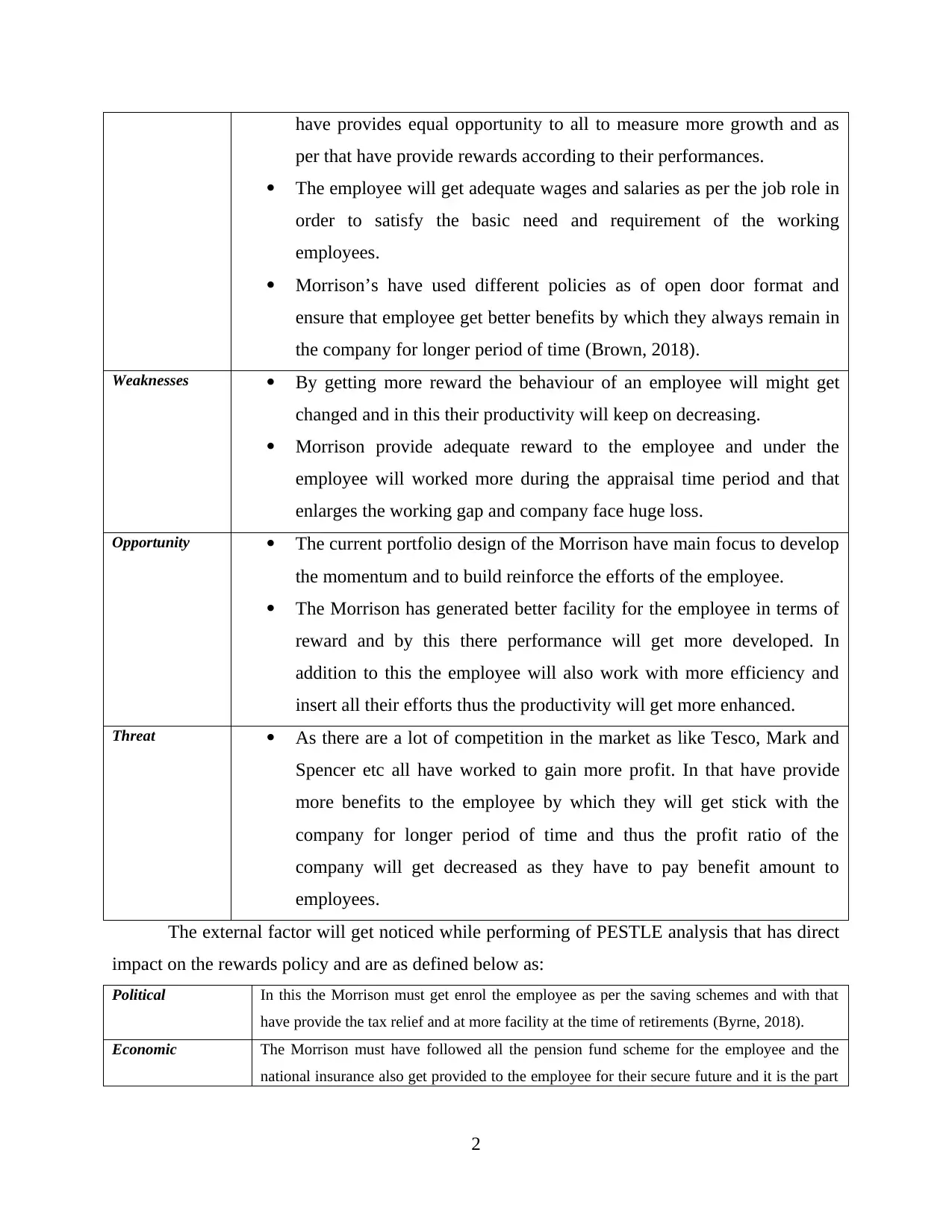
have provides equal opportunity to all to measure more growth and as
per that have provide rewards according to their performances.
The employee will get adequate wages and salaries as per the job role in
order to satisfy the basic need and requirement of the working
employees.
Morrison’s have used different policies as of open door format and
ensure that employee get better benefits by which they always remain in
the company for longer period of time (Brown, 2018).
Weaknesses By getting more reward the behaviour of an employee will might get
changed and in this their productivity will keep on decreasing.
Morrison provide adequate reward to the employee and under the
employee will worked more during the appraisal time period and that
enlarges the working gap and company face huge loss.
Opportunity The current portfolio design of the Morrison have main focus to develop
the momentum and to build reinforce the efforts of the employee.
The Morrison has generated better facility for the employee in terms of
reward and by this there performance will get more developed. In
addition to this the employee will also work with more efficiency and
insert all their efforts thus the productivity will get more enhanced.
Threat As there are a lot of competition in the market as like Tesco, Mark and
Spencer etc all have worked to gain more profit. In that have provide
more benefits to the employee by which they will get stick with the
company for longer period of time and thus the profit ratio of the
company will get decreased as they have to pay benefit amount to
employees.
The external factor will get noticed while performing of PESTLE analysis that has direct
impact on the rewards policy and are as defined below as:
Political In this the Morrison must get enrol the employee as per the saving schemes and with that
have provide the tax relief and at more facility at the time of retirements (Byrne, 2018).
Economic The Morrison must have followed all the pension fund scheme for the employee and the
national insurance also get provided to the employee for their secure future and it is the part
2
per that have provide rewards according to their performances.
The employee will get adequate wages and salaries as per the job role in
order to satisfy the basic need and requirement of the working
employees.
Morrison’s have used different policies as of open door format and
ensure that employee get better benefits by which they always remain in
the company for longer period of time (Brown, 2018).
Weaknesses By getting more reward the behaviour of an employee will might get
changed and in this their productivity will keep on decreasing.
Morrison provide adequate reward to the employee and under the
employee will worked more during the appraisal time period and that
enlarges the working gap and company face huge loss.
Opportunity The current portfolio design of the Morrison have main focus to develop
the momentum and to build reinforce the efforts of the employee.
The Morrison has generated better facility for the employee in terms of
reward and by this there performance will get more developed. In
addition to this the employee will also work with more efficiency and
insert all their efforts thus the productivity will get more enhanced.
Threat As there are a lot of competition in the market as like Tesco, Mark and
Spencer etc all have worked to gain more profit. In that have provide
more benefits to the employee by which they will get stick with the
company for longer period of time and thus the profit ratio of the
company will get decreased as they have to pay benefit amount to
employees.
The external factor will get noticed while performing of PESTLE analysis that has direct
impact on the rewards policy and are as defined below as:
Political In this the Morrison must get enrol the employee as per the saving schemes and with that
have provide the tax relief and at more facility at the time of retirements (Byrne, 2018).
Economic The Morrison must have followed all the pension fund scheme for the employee and the
national insurance also get provided to the employee for their secure future and it is the part
2
Paraphrase This Document
Need a fresh take? Get an instant paraphrase of this document with our AI Paraphraser
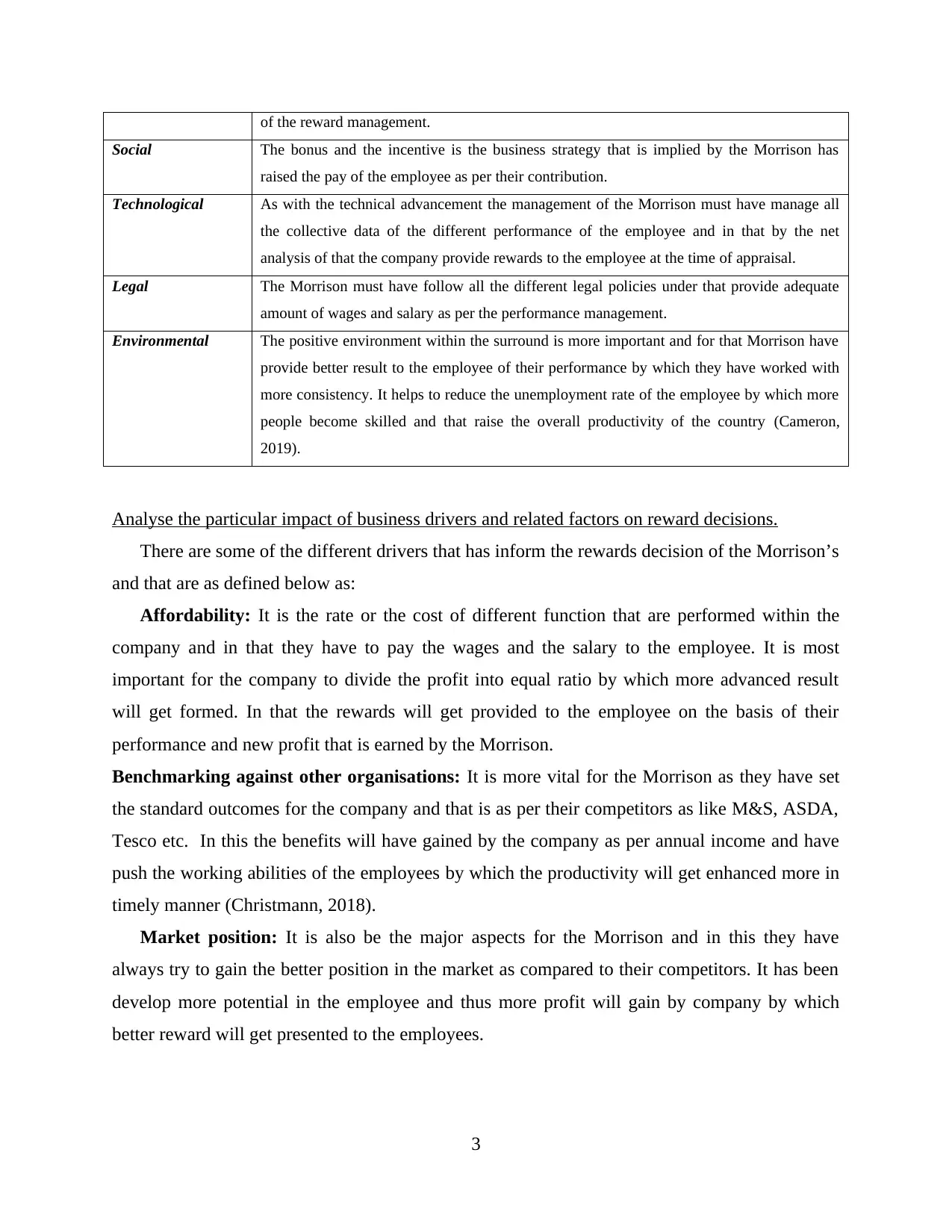
of the reward management.
Social The bonus and the incentive is the business strategy that is implied by the Morrison has
raised the pay of the employee as per their contribution.
Technological As with the technical advancement the management of the Morrison must have manage all
the collective data of the different performance of the employee and in that by the net
analysis of that the company provide rewards to the employee at the time of appraisal.
Legal The Morrison must have follow all the different legal policies under that provide adequate
amount of wages and salary as per the performance management.
Environmental The positive environment within the surround is more important and for that Morrison have
provide better result to the employee of their performance by which they have worked with
more consistency. It helps to reduce the unemployment rate of the employee by which more
people become skilled and that raise the overall productivity of the country (Cameron,
2019).
Analyse the particular impact of business drivers and related factors on reward decisions.
There are some of the different drivers that has inform the rewards decision of the Morrison’s
and that are as defined below as:
Affordability: It is the rate or the cost of different function that are performed within the
company and in that they have to pay the wages and the salary to the employee. It is most
important for the company to divide the profit into equal ratio by which more advanced result
will get formed. In that the rewards will get provided to the employee on the basis of their
performance and new profit that is earned by the Morrison.
Benchmarking against other organisations: It is more vital for the Morrison as they have set
the standard outcomes for the company and that is as per their competitors as like M&S, ASDA,
Tesco etc. In this the benefits will have gained by the company as per annual income and have
push the working abilities of the employees by which the productivity will get enhanced more in
timely manner (Christmann, 2018).
Market position: It is also be the major aspects for the Morrison and in this they have
always try to gain the better position in the market as compared to their competitors. It has been
develop more potential in the employee and thus more profit will gain by company by which
better reward will get presented to the employees.
3
Social The bonus and the incentive is the business strategy that is implied by the Morrison has
raised the pay of the employee as per their contribution.
Technological As with the technical advancement the management of the Morrison must have manage all
the collective data of the different performance of the employee and in that by the net
analysis of that the company provide rewards to the employee at the time of appraisal.
Legal The Morrison must have follow all the different legal policies under that provide adequate
amount of wages and salary as per the performance management.
Environmental The positive environment within the surround is more important and for that Morrison have
provide better result to the employee of their performance by which they have worked with
more consistency. It helps to reduce the unemployment rate of the employee by which more
people become skilled and that raise the overall productivity of the country (Cameron,
2019).
Analyse the particular impact of business drivers and related factors on reward decisions.
There are some of the different drivers that has inform the rewards decision of the Morrison’s
and that are as defined below as:
Affordability: It is the rate or the cost of different function that are performed within the
company and in that they have to pay the wages and the salary to the employee. It is most
important for the company to divide the profit into equal ratio by which more advanced result
will get formed. In that the rewards will get provided to the employee on the basis of their
performance and new profit that is earned by the Morrison.
Benchmarking against other organisations: It is more vital for the Morrison as they have set
the standard outcomes for the company and that is as per their competitors as like M&S, ASDA,
Tesco etc. In this the benefits will have gained by the company as per annual income and have
push the working abilities of the employees by which the productivity will get enhanced more in
timely manner (Christmann, 2018).
Market position: It is also be the major aspects for the Morrison and in this they have
always try to gain the better position in the market as compared to their competitors. It has been
develop more potential in the employee and thus more profit will gain by company by which
better reward will get presented to the employees.
3
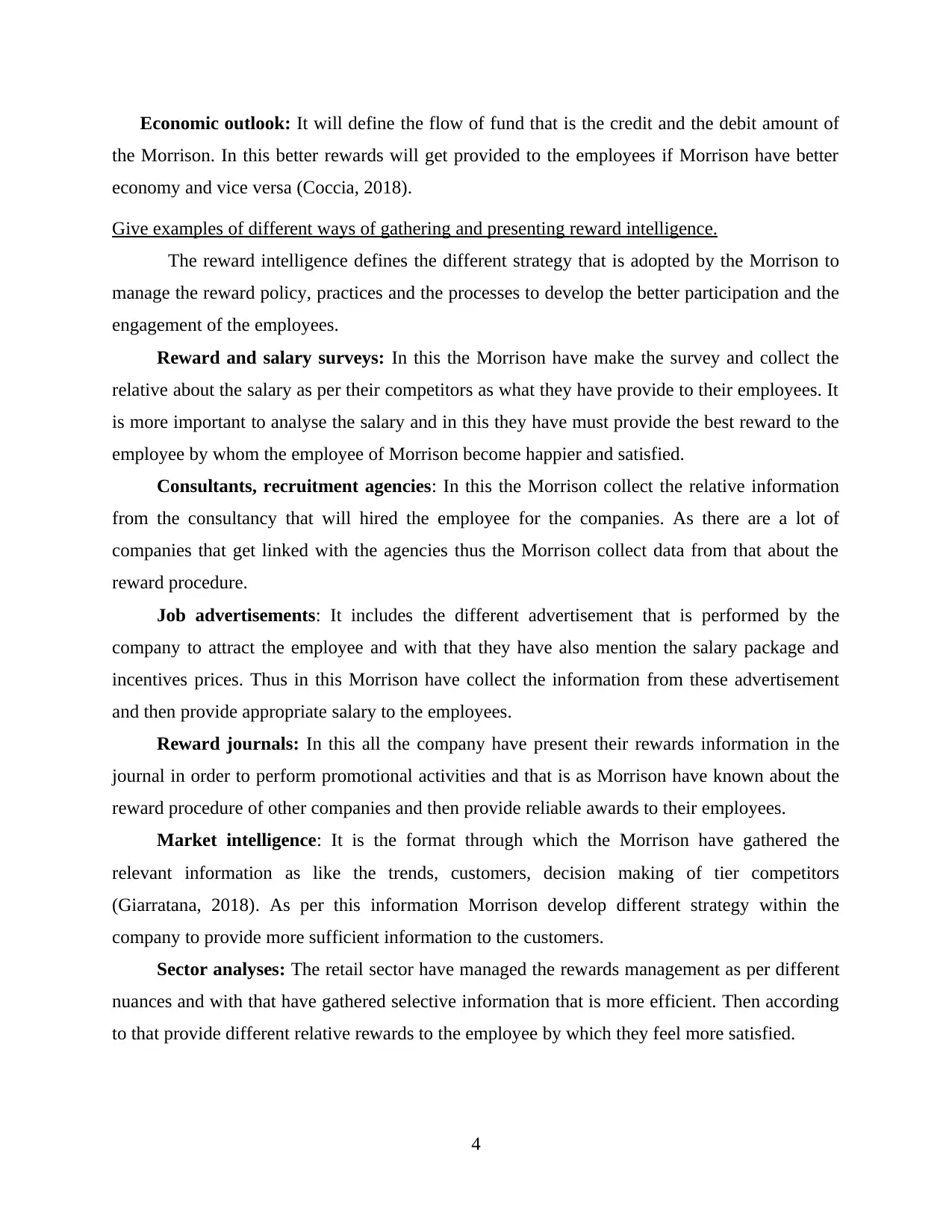
Economic outlook: It will define the flow of fund that is the credit and the debit amount of
the Morrison. In this better rewards will get provided to the employees if Morrison have better
economy and vice versa (Coccia, 2018).
Give examples of different ways of gathering and presenting reward intelligence.
The reward intelligence defines the different strategy that is adopted by the Morrison to
manage the reward policy, practices and the processes to develop the better participation and the
engagement of the employees.
Reward and salary surveys: In this the Morrison have make the survey and collect the
relative about the salary as per their competitors as what they have provide to their employees. It
is more important to analyse the salary and in this they have must provide the best reward to the
employee by whom the employee of Morrison become happier and satisfied.
Consultants, recruitment agencies: In this the Morrison collect the relative information
from the consultancy that will hired the employee for the companies. As there are a lot of
companies that get linked with the agencies thus the Morrison collect data from that about the
reward procedure.
Job advertisements: It includes the different advertisement that is performed by the
company to attract the employee and with that they have also mention the salary package and
incentives prices. Thus in this Morrison have collect the information from these advertisement
and then provide appropriate salary to the employees.
Reward journals: In this all the company have present their rewards information in the
journal in order to perform promotional activities and that is as Morrison have known about the
reward procedure of other companies and then provide reliable awards to their employees.
Market intelligence: It is the format through which the Morrison have gathered the
relevant information as like the trends, customers, decision making of tier competitors
(Giarratana, 2018). As per this information Morrison develop different strategy within the
company to provide more sufficient information to the customers.
Sector analyses: The retail sector have managed the rewards management as per different
nuances and with that have gathered selective information that is more efficient. Then according
to that provide different relative rewards to the employee by which they feel more satisfied.
4
the Morrison. In this better rewards will get provided to the employees if Morrison have better
economy and vice versa (Coccia, 2018).
Give examples of different ways of gathering and presenting reward intelligence.
The reward intelligence defines the different strategy that is adopted by the Morrison to
manage the reward policy, practices and the processes to develop the better participation and the
engagement of the employees.
Reward and salary surveys: In this the Morrison have make the survey and collect the
relative about the salary as per their competitors as what they have provide to their employees. It
is more important to analyse the salary and in this they have must provide the best reward to the
employee by whom the employee of Morrison become happier and satisfied.
Consultants, recruitment agencies: In this the Morrison collect the relative information
from the consultancy that will hired the employee for the companies. As there are a lot of
companies that get linked with the agencies thus the Morrison collect data from that about the
reward procedure.
Job advertisements: It includes the different advertisement that is performed by the
company to attract the employee and with that they have also mention the salary package and
incentives prices. Thus in this Morrison have collect the information from these advertisement
and then provide appropriate salary to the employees.
Reward journals: In this all the company have present their rewards information in the
journal in order to perform promotional activities and that is as Morrison have known about the
reward procedure of other companies and then provide reliable awards to their employees.
Market intelligence: It is the format through which the Morrison have gathered the
relevant information as like the trends, customers, decision making of tier competitors
(Giarratana, 2018). As per this information Morrison develop different strategy within the
company to provide more sufficient information to the customers.
Sector analyses: The retail sector have managed the rewards management as per different
nuances and with that have gathered selective information that is more efficient. Then according
to that provide different relative rewards to the employee by which they feel more satisfied.
4
⊘ This is a preview!⊘
Do you want full access?
Subscribe today to unlock all pages.

Trusted by 1+ million students worldwide
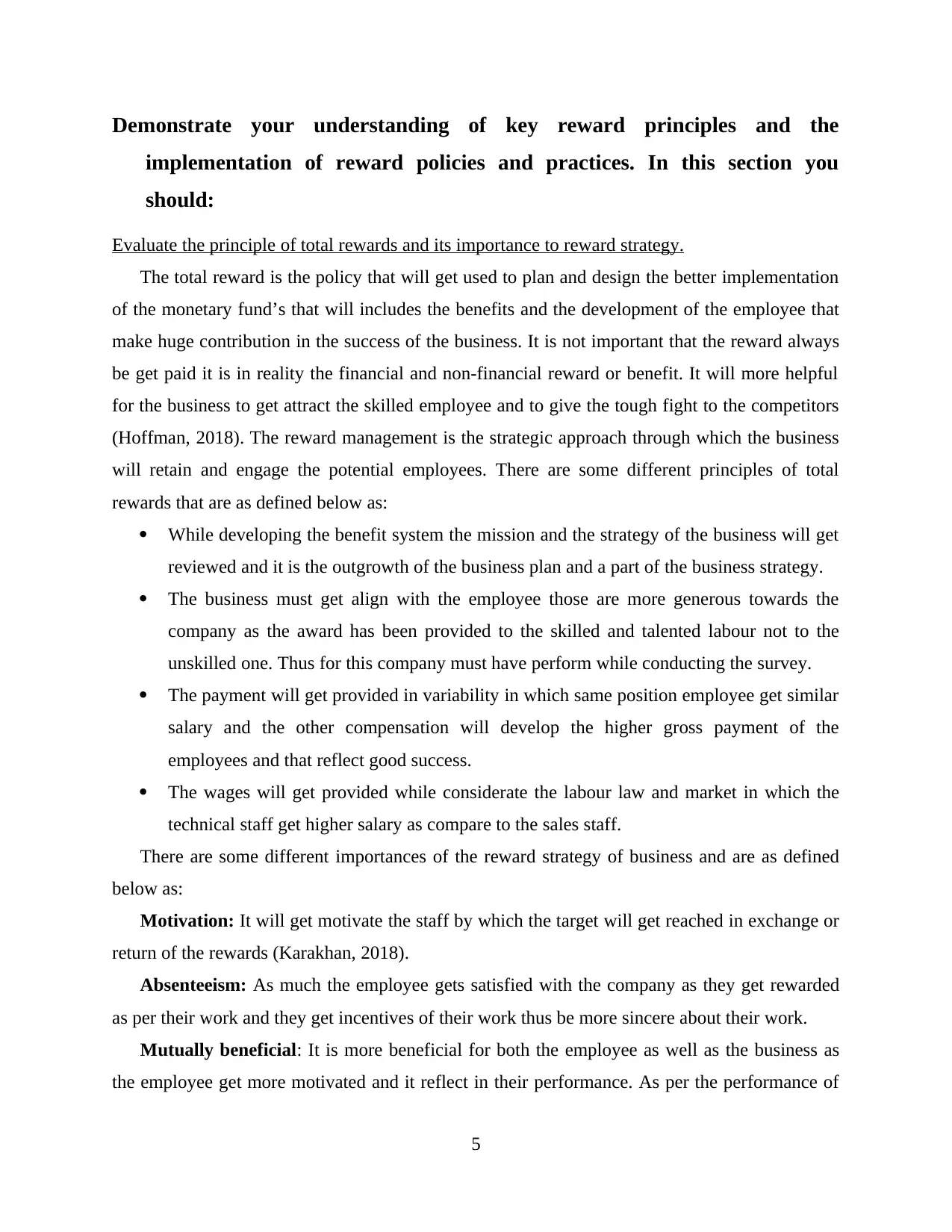
Demonstrate your understanding of key reward principles and the
implementation of reward policies and practices. In this section you
should:
Evaluate the principle of total rewards and its importance to reward strategy.
The total reward is the policy that will get used to plan and design the better implementation
of the monetary fund’s that will includes the benefits and the development of the employee that
make huge contribution in the success of the business. It is not important that the reward always
be get paid it is in reality the financial and non-financial reward or benefit. It will more helpful
for the business to get attract the skilled employee and to give the tough fight to the competitors
(Hoffman, 2018). The reward management is the strategic approach through which the business
will retain and engage the potential employees. There are some different principles of total
rewards that are as defined below as:
While developing the benefit system the mission and the strategy of the business will get
reviewed and it is the outgrowth of the business plan and a part of the business strategy.
The business must get align with the employee those are more generous towards the
company as the award has been provided to the skilled and talented labour not to the
unskilled one. Thus for this company must have perform while conducting the survey.
The payment will get provided in variability in which same position employee get similar
salary and the other compensation will develop the higher gross payment of the
employees and that reflect good success.
The wages will get provided while considerate the labour law and market in which the
technical staff get higher salary as compare to the sales staff.
There are some different importances of the reward strategy of business and are as defined
below as:
Motivation: It will get motivate the staff by which the target will get reached in exchange or
return of the rewards (Karakhan, 2018).
Absenteeism: As much the employee gets satisfied with the company as they get rewarded
as per their work and they get incentives of their work thus be more sincere about their work.
Mutually beneficial: It is more beneficial for both the employee as well as the business as
the employee get more motivated and it reflect in their performance. As per the performance of
5
implementation of reward policies and practices. In this section you
should:
Evaluate the principle of total rewards and its importance to reward strategy.
The total reward is the policy that will get used to plan and design the better implementation
of the monetary fund’s that will includes the benefits and the development of the employee that
make huge contribution in the success of the business. It is not important that the reward always
be get paid it is in reality the financial and non-financial reward or benefit. It will more helpful
for the business to get attract the skilled employee and to give the tough fight to the competitors
(Hoffman, 2018). The reward management is the strategic approach through which the business
will retain and engage the potential employees. There are some different principles of total
rewards that are as defined below as:
While developing the benefit system the mission and the strategy of the business will get
reviewed and it is the outgrowth of the business plan and a part of the business strategy.
The business must get align with the employee those are more generous towards the
company as the award has been provided to the skilled and talented labour not to the
unskilled one. Thus for this company must have perform while conducting the survey.
The payment will get provided in variability in which same position employee get similar
salary and the other compensation will develop the higher gross payment of the
employees and that reflect good success.
The wages will get provided while considerate the labour law and market in which the
technical staff get higher salary as compare to the sales staff.
There are some different importances of the reward strategy of business and are as defined
below as:
Motivation: It will get motivate the staff by which the target will get reached in exchange or
return of the rewards (Karakhan, 2018).
Absenteeism: As much the employee gets satisfied with the company as they get rewarded
as per their work and they get incentives of their work thus be more sincere about their work.
Mutually beneficial: It is more beneficial for both the employee as well as the business as
the employee get more motivated and it reflect in their performance. As per the performance of
5
Paraphrase This Document
Need a fresh take? Get an instant paraphrase of this document with our AI Paraphraser
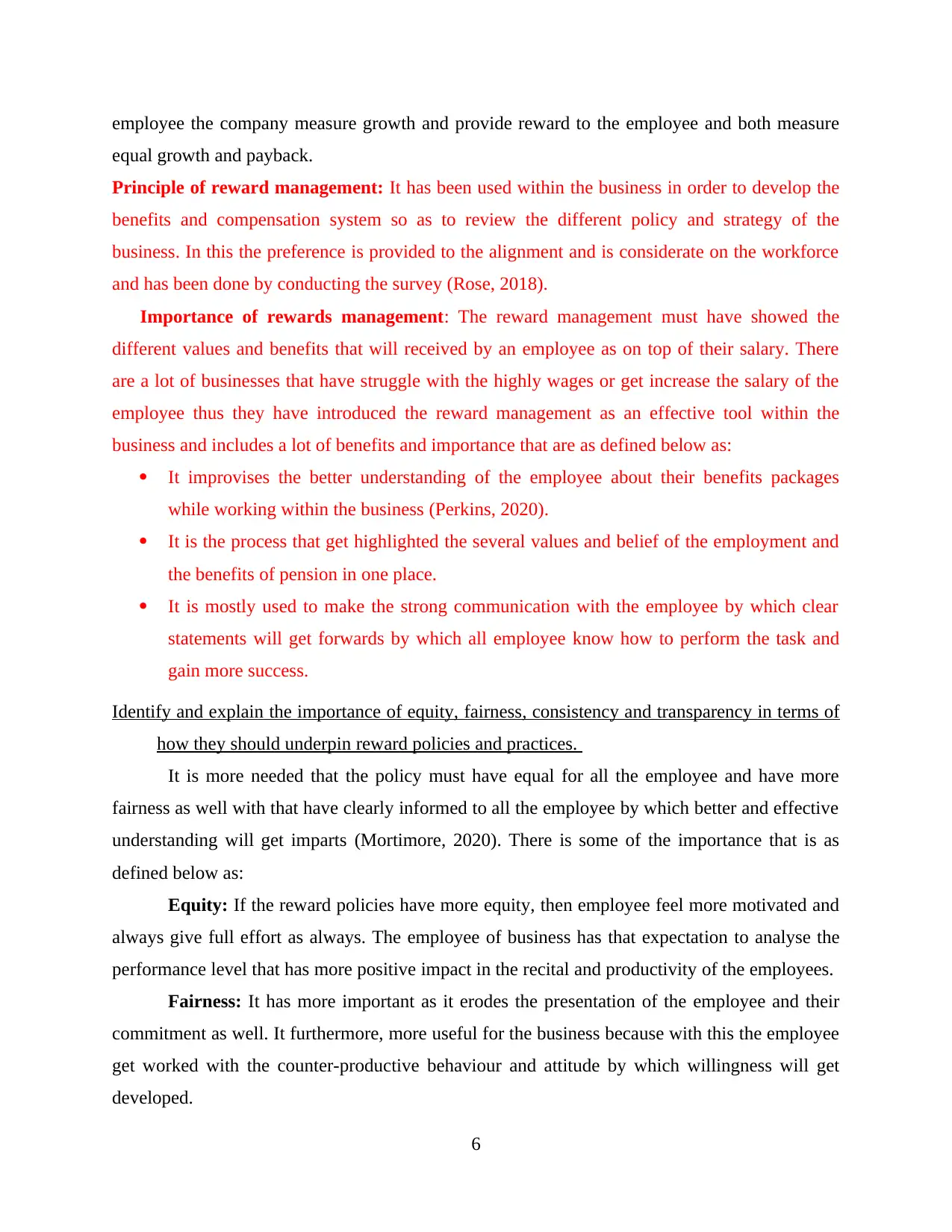
employee the company measure growth and provide reward to the employee and both measure
equal growth and payback.
Principle of reward management: It has been used within the business in order to develop the
benefits and compensation system so as to review the different policy and strategy of the
business. In this the preference is provided to the alignment and is considerate on the workforce
and has been done by conducting the survey (Rose, 2018).
Importance of rewards management: The reward management must have showed the
different values and benefits that will received by an employee as on top of their salary. There
are a lot of businesses that have struggle with the highly wages or get increase the salary of the
employee thus they have introduced the reward management as an effective tool within the
business and includes a lot of benefits and importance that are as defined below as:
It improvises the better understanding of the employee about their benefits packages
while working within the business (Perkins, 2020).
It is the process that get highlighted the several values and belief of the employment and
the benefits of pension in one place.
It is mostly used to make the strong communication with the employee by which clear
statements will get forwards by which all employee know how to perform the task and
gain more success.
Identify and explain the importance of equity, fairness, consistency and transparency in terms of
how they should underpin reward policies and practices.
It is more needed that the policy must have equal for all the employee and have more
fairness as well with that have clearly informed to all the employee by which better and effective
understanding will get imparts (Mortimore, 2020). There is some of the importance that is as
defined below as:
Equity: If the reward policies have more equity, then employee feel more motivated and
always give full effort as always. The employee of business has that expectation to analyse the
performance level that has more positive impact in the recital and productivity of the employees.
Fairness: It has more important as it erodes the presentation of the employee and their
commitment as well. It furthermore, more useful for the business because with this the employee
get worked with the counter-productive behaviour and attitude by which willingness will get
developed.
6
equal growth and payback.
Principle of reward management: It has been used within the business in order to develop the
benefits and compensation system so as to review the different policy and strategy of the
business. In this the preference is provided to the alignment and is considerate on the workforce
and has been done by conducting the survey (Rose, 2018).
Importance of rewards management: The reward management must have showed the
different values and benefits that will received by an employee as on top of their salary. There
are a lot of businesses that have struggle with the highly wages or get increase the salary of the
employee thus they have introduced the reward management as an effective tool within the
business and includes a lot of benefits and importance that are as defined below as:
It improvises the better understanding of the employee about their benefits packages
while working within the business (Perkins, 2020).
It is the process that get highlighted the several values and belief of the employment and
the benefits of pension in one place.
It is mostly used to make the strong communication with the employee by which clear
statements will get forwards by which all employee know how to perform the task and
gain more success.
Identify and explain the importance of equity, fairness, consistency and transparency in terms of
how they should underpin reward policies and practices.
It is more needed that the policy must have equal for all the employee and have more
fairness as well with that have clearly informed to all the employee by which better and effective
understanding will get imparts (Mortimore, 2020). There is some of the importance that is as
defined below as:
Equity: If the reward policies have more equity, then employee feel more motivated and
always give full effort as always. The employee of business has that expectation to analyse the
performance level that has more positive impact in the recital and productivity of the employees.
Fairness: It has more important as it erodes the presentation of the employee and their
commitment as well. It furthermore, more useful for the business because with this the employee
get worked with the counter-productive behaviour and attitude by which willingness will get
developed.
6
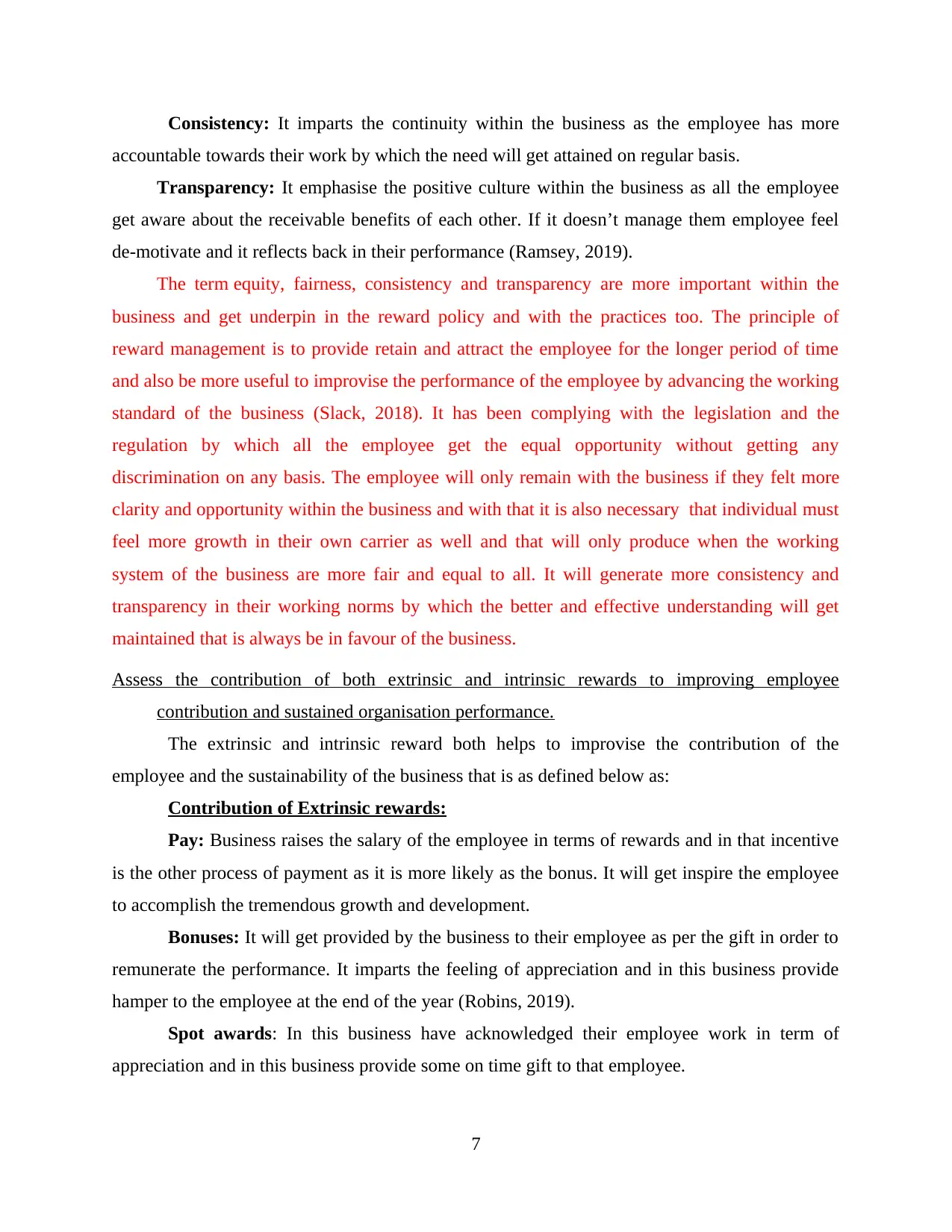
Consistency: It imparts the continuity within the business as the employee has more
accountable towards their work by which the need will get attained on regular basis.
Transparency: It emphasise the positive culture within the business as all the employee
get aware about the receivable benefits of each other. If it doesn’t manage them employee feel
de-motivate and it reflects back in their performance (Ramsey, 2019).
The term equity, fairness, consistency and transparency are more important within the
business and get underpin in the reward policy and with the practices too. The principle of
reward management is to provide retain and attract the employee for the longer period of time
and also be more useful to improvise the performance of the employee by advancing the working
standard of the business (Slack, 2018). It has been complying with the legislation and the
regulation by which all the employee get the equal opportunity without getting any
discrimination on any basis. The employee will only remain with the business if they felt more
clarity and opportunity within the business and with that it is also necessary that individual must
feel more growth in their own carrier as well and that will only produce when the working
system of the business are more fair and equal to all. It will generate more consistency and
transparency in their working norms by which the better and effective understanding will get
maintained that is always be in favour of the business.
Assess the contribution of both extrinsic and intrinsic rewards to improving employee
contribution and sustained organisation performance.
The extrinsic and intrinsic reward both helps to improvise the contribution of the
employee and the sustainability of the business that is as defined below as:
Contribution of Extrinsic rewards:
Pay: Business raises the salary of the employee in terms of rewards and in that incentive
is the other process of payment as it is more likely as the bonus. It will get inspire the employee
to accomplish the tremendous growth and development.
Bonuses: It will get provided by the business to their employee as per the gift in order to
remunerate the performance. It imparts the feeling of appreciation and in this business provide
hamper to the employee at the end of the year (Robins, 2019).
Spot awards: In this business have acknowledged their employee work in term of
appreciation and in this business provide some on time gift to that employee.
7
accountable towards their work by which the need will get attained on regular basis.
Transparency: It emphasise the positive culture within the business as all the employee
get aware about the receivable benefits of each other. If it doesn’t manage them employee feel
de-motivate and it reflects back in their performance (Ramsey, 2019).
The term equity, fairness, consistency and transparency are more important within the
business and get underpin in the reward policy and with the practices too. The principle of
reward management is to provide retain and attract the employee for the longer period of time
and also be more useful to improvise the performance of the employee by advancing the working
standard of the business (Slack, 2018). It has been complying with the legislation and the
regulation by which all the employee get the equal opportunity without getting any
discrimination on any basis. The employee will only remain with the business if they felt more
clarity and opportunity within the business and with that it is also necessary that individual must
feel more growth in their own carrier as well and that will only produce when the working
system of the business are more fair and equal to all. It will generate more consistency and
transparency in their working norms by which the better and effective understanding will get
maintained that is always be in favour of the business.
Assess the contribution of both extrinsic and intrinsic rewards to improving employee
contribution and sustained organisation performance.
The extrinsic and intrinsic reward both helps to improvise the contribution of the
employee and the sustainability of the business that is as defined below as:
Contribution of Extrinsic rewards:
Pay: Business raises the salary of the employee in terms of rewards and in that incentive
is the other process of payment as it is more likely as the bonus. It will get inspire the employee
to accomplish the tremendous growth and development.
Bonuses: It will get provided by the business to their employee as per the gift in order to
remunerate the performance. It imparts the feeling of appreciation and in this business provide
hamper to the employee at the end of the year (Robins, 2019).
Spot awards: In this business have acknowledged their employee work in term of
appreciation and in this business provide some on time gift to that employee.
7
⊘ This is a preview!⊘
Do you want full access?
Subscribe today to unlock all pages.

Trusted by 1+ million students worldwide

Promotion: It is more important to pick the right person for the company and in that
business measure all the abilities and then provide the promotion on yearly basis.
Recognition: It refers to the acknowledgement of employee work in term of praise and
by providing the special attention to that employee.
Contribution of intrinsic rewards:
Completion: In this some of the employee have value more to their task and accomplish
that within the certain period of time. It helps the employee of business to lead the company and
set the example in front of others.
Achievements: It is also being the self-administered reward and in this the goals of
company will get challenged and must get attain with more perfection by managing all the
redundancies.
Autonomy: In this the employee want some relief and freedom and take their individual
decision by their own by which they have feel the sense of autonomy.
Personal growth: It is relative to the individual effort that helps to make themselves
different from the others and in this the individual push their limits and that is more helpful to
achieve better result in future (Snyder, 2018).
As per the viewpoint of Shraddha Bajracharya, 2018, reward is the benefit that is provided
by the business to their employee and usually it is in the form of money, promotion that get drive
the feeling of satisfaction and a pride to be part of a effective team and business. Intrinsic reward
is also be known as the non-physical rewards as it cant’s be seen but employee get emotional
connect with this and induce the feeling of contentment that get find after the completion of the
task. It will also get induce the sense of achievements, a praise from the higher level authority or
from the seniors, recognition, feeling of price while working in a job, imparts the sense of
autonomy and freedom of work (Khern-am-nuai, 2018). On the other hand the extrinsic reward is
more important as it comes in the physical form and directly relatable to the performance of an
employee. There are some different way that get chosen by the company in order to provide the
reward as like in the form of pay, commission, bonus, fringe that get provide the additional
benefits, improvises the working condition, sharing of the profit, promotions,
Explain how reward policy initiatives and practices are implemented in your chosen organisation
The reward policy and the initiative and practices were get implements within the
Morrison by following some certain steps that are as defined below as:
8
business measure all the abilities and then provide the promotion on yearly basis.
Recognition: It refers to the acknowledgement of employee work in term of praise and
by providing the special attention to that employee.
Contribution of intrinsic rewards:
Completion: In this some of the employee have value more to their task and accomplish
that within the certain period of time. It helps the employee of business to lead the company and
set the example in front of others.
Achievements: It is also being the self-administered reward and in this the goals of
company will get challenged and must get attain with more perfection by managing all the
redundancies.
Autonomy: In this the employee want some relief and freedom and take their individual
decision by their own by which they have feel the sense of autonomy.
Personal growth: It is relative to the individual effort that helps to make themselves
different from the others and in this the individual push their limits and that is more helpful to
achieve better result in future (Snyder, 2018).
As per the viewpoint of Shraddha Bajracharya, 2018, reward is the benefit that is provided
by the business to their employee and usually it is in the form of money, promotion that get drive
the feeling of satisfaction and a pride to be part of a effective team and business. Intrinsic reward
is also be known as the non-physical rewards as it cant’s be seen but employee get emotional
connect with this and induce the feeling of contentment that get find after the completion of the
task. It will also get induce the sense of achievements, a praise from the higher level authority or
from the seniors, recognition, feeling of price while working in a job, imparts the sense of
autonomy and freedom of work (Khern-am-nuai, 2018). On the other hand the extrinsic reward is
more important as it comes in the physical form and directly relatable to the performance of an
employee. There are some different way that get chosen by the company in order to provide the
reward as like in the form of pay, commission, bonus, fringe that get provide the additional
benefits, improvises the working condition, sharing of the profit, promotions,
Explain how reward policy initiatives and practices are implemented in your chosen organisation
The reward policy and the initiative and practices were get implements within the
Morrison by following some certain steps that are as defined below as:
8
Paraphrase This Document
Need a fresh take? Get an instant paraphrase of this document with our AI Paraphraser
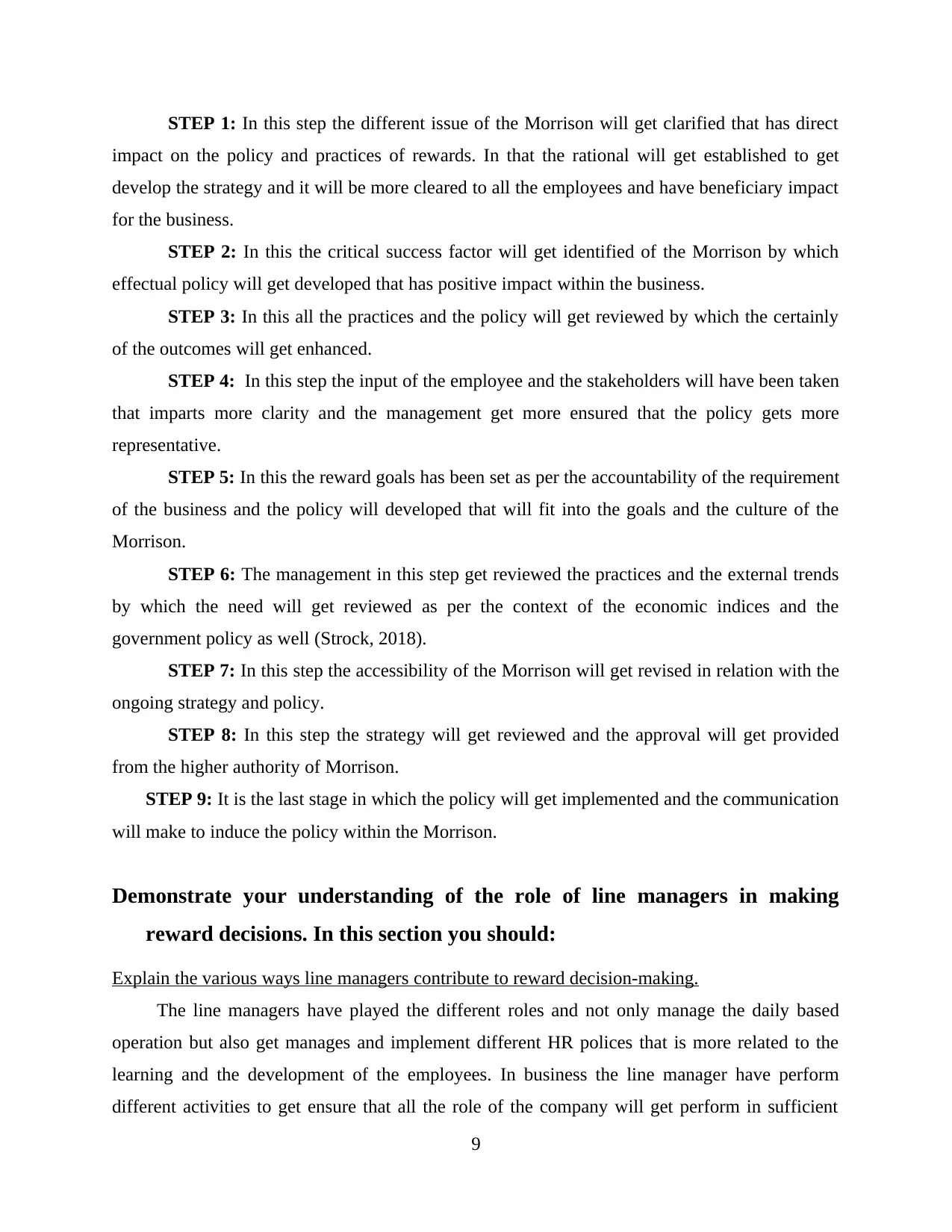
STEP 1: In this step the different issue of the Morrison will get clarified that has direct
impact on the policy and practices of rewards. In that the rational will get established to get
develop the strategy and it will be more cleared to all the employees and have beneficiary impact
for the business.
STEP 2: In this the critical success factor will get identified of the Morrison by which
effectual policy will get developed that has positive impact within the business.
STEP 3: In this all the practices and the policy will get reviewed by which the certainly
of the outcomes will get enhanced.
STEP 4: In this step the input of the employee and the stakeholders will have been taken
that imparts more clarity and the management get more ensured that the policy gets more
representative.
STEP 5: In this the reward goals has been set as per the accountability of the requirement
of the business and the policy will developed that will fit into the goals and the culture of the
Morrison.
STEP 6: The management in this step get reviewed the practices and the external trends
by which the need will get reviewed as per the context of the economic indices and the
government policy as well (Strock, 2018).
STEP 7: In this step the accessibility of the Morrison will get revised in relation with the
ongoing strategy and policy.
STEP 8: In this step the strategy will get reviewed and the approval will get provided
from the higher authority of Morrison.
STEP 9: It is the last stage in which the policy will get implemented and the communication
will make to induce the policy within the Morrison.
Demonstrate your understanding of the role of line managers in making
reward decisions. In this section you should:
Explain the various ways line managers contribute to reward decision-making.
The line managers have played the different roles and not only manage the daily based
operation but also get manages and implement different HR polices that is more related to the
learning and the development of the employees. In business the line manager have perform
different activities to get ensure that all the role of the company will get perform in sufficient
9
impact on the policy and practices of rewards. In that the rational will get established to get
develop the strategy and it will be more cleared to all the employees and have beneficiary impact
for the business.
STEP 2: In this the critical success factor will get identified of the Morrison by which
effectual policy will get developed that has positive impact within the business.
STEP 3: In this all the practices and the policy will get reviewed by which the certainly
of the outcomes will get enhanced.
STEP 4: In this step the input of the employee and the stakeholders will have been taken
that imparts more clarity and the management get more ensured that the policy gets more
representative.
STEP 5: In this the reward goals has been set as per the accountability of the requirement
of the business and the policy will developed that will fit into the goals and the culture of the
Morrison.
STEP 6: The management in this step get reviewed the practices and the external trends
by which the need will get reviewed as per the context of the economic indices and the
government policy as well (Strock, 2018).
STEP 7: In this step the accessibility of the Morrison will get revised in relation with the
ongoing strategy and policy.
STEP 8: In this step the strategy will get reviewed and the approval will get provided
from the higher authority of Morrison.
STEP 9: It is the last stage in which the policy will get implemented and the communication
will make to induce the policy within the Morrison.
Demonstrate your understanding of the role of line managers in making
reward decisions. In this section you should:
Explain the various ways line managers contribute to reward decision-making.
The line managers have played the different roles and not only manage the daily based
operation but also get manages and implement different HR polices that is more related to the
learning and the development of the employees. In business the line manager have perform
different activities to get ensure that all the role of the company will get perform in sufficient
9
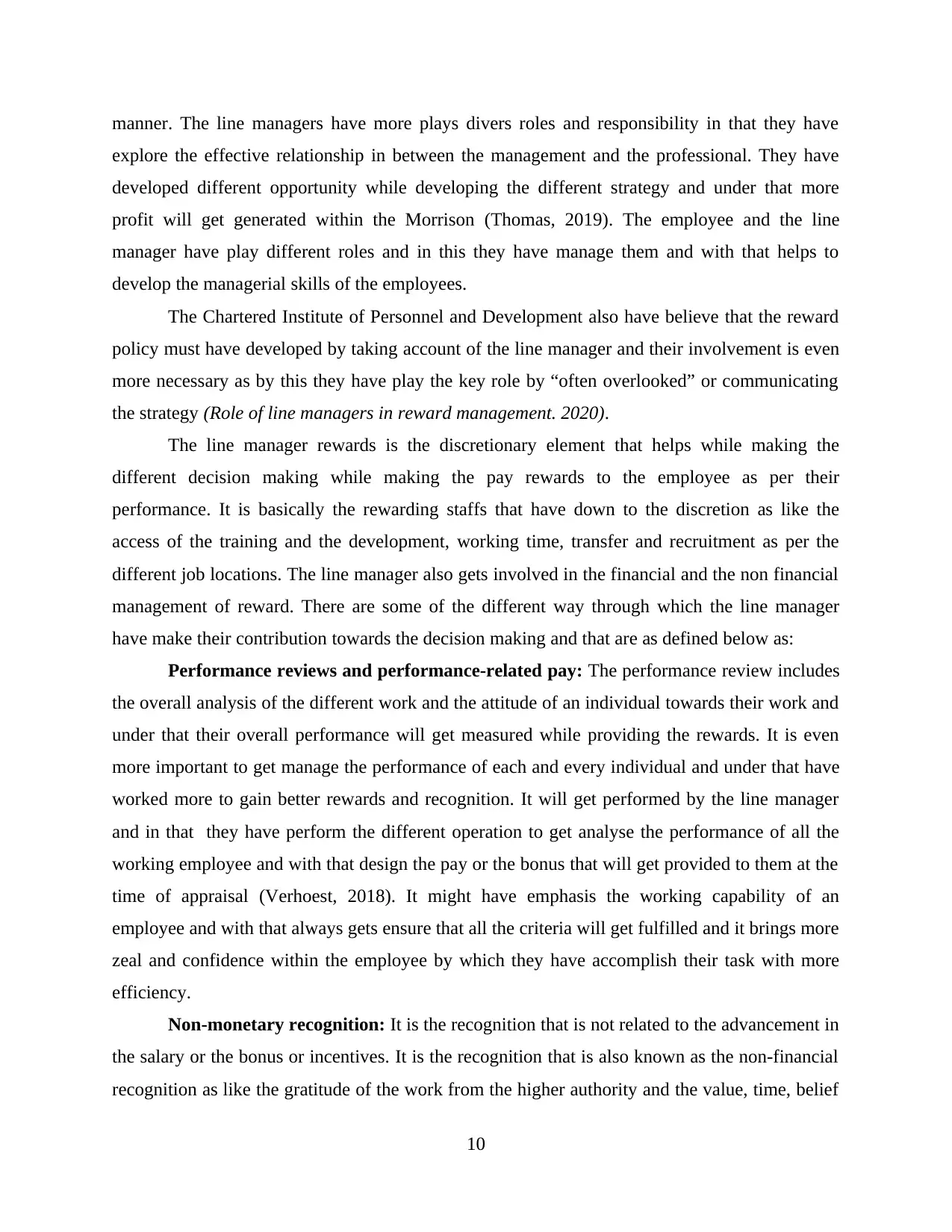
manner. The line managers have more plays divers roles and responsibility in that they have
explore the effective relationship in between the management and the professional. They have
developed different opportunity while developing the different strategy and under that more
profit will get generated within the Morrison (Thomas, 2019). The employee and the line
manager have play different roles and in this they have manage them and with that helps to
develop the managerial skills of the employees.
The Chartered Institute of Personnel and Development also have believe that the reward
policy must have developed by taking account of the line manager and their involvement is even
more necessary as by this they have play the key role by “often overlooked” or communicating
the strategy (Role of line managers in reward management. 2020).
The line manager rewards is the discretionary element that helps while making the
different decision making while making the pay rewards to the employee as per their
performance. It is basically the rewarding staffs that have down to the discretion as like the
access of the training and the development, working time, transfer and recruitment as per the
different job locations. The line manager also gets involved in the financial and the non financial
management of reward. There are some of the different way through which the line manager
have make their contribution towards the decision making and that are as defined below as:
Performance reviews and performance-related pay: The performance review includes
the overall analysis of the different work and the attitude of an individual towards their work and
under that their overall performance will get measured while providing the rewards. It is even
more important to get manage the performance of each and every individual and under that have
worked more to gain better rewards and recognition. It will get performed by the line manager
and in that they have perform the different operation to get analyse the performance of all the
working employee and with that design the pay or the bonus that will get provided to them at the
time of appraisal (Verhoest, 2018). It might have emphasis the working capability of an
employee and with that always gets ensure that all the criteria will get fulfilled and it brings more
zeal and confidence within the employee by which they have accomplish their task with more
efficiency.
Non-monetary recognition: It is the recognition that is not related to the advancement in
the salary or the bonus or incentives. It is the recognition that is also known as the non-financial
recognition as like the gratitude of the work from the higher authority and the value, time, belief
10
explore the effective relationship in between the management and the professional. They have
developed different opportunity while developing the different strategy and under that more
profit will get generated within the Morrison (Thomas, 2019). The employee and the line
manager have play different roles and in this they have manage them and with that helps to
develop the managerial skills of the employees.
The Chartered Institute of Personnel and Development also have believe that the reward
policy must have developed by taking account of the line manager and their involvement is even
more necessary as by this they have play the key role by “often overlooked” or communicating
the strategy (Role of line managers in reward management. 2020).
The line manager rewards is the discretionary element that helps while making the
different decision making while making the pay rewards to the employee as per their
performance. It is basically the rewarding staffs that have down to the discretion as like the
access of the training and the development, working time, transfer and recruitment as per the
different job locations. The line manager also gets involved in the financial and the non financial
management of reward. There are some of the different way through which the line manager
have make their contribution towards the decision making and that are as defined below as:
Performance reviews and performance-related pay: The performance review includes
the overall analysis of the different work and the attitude of an individual towards their work and
under that their overall performance will get measured while providing the rewards. It is even
more important to get manage the performance of each and every individual and under that have
worked more to gain better rewards and recognition. It will get performed by the line manager
and in that they have perform the different operation to get analyse the performance of all the
working employee and with that design the pay or the bonus that will get provided to them at the
time of appraisal (Verhoest, 2018). It might have emphasis the working capability of an
employee and with that always gets ensure that all the criteria will get fulfilled and it brings more
zeal and confidence within the employee by which they have accomplish their task with more
efficiency.
Non-monetary recognition: It is the recognition that is not related to the advancement in
the salary or the bonus or incentives. It is the recognition that is also known as the non-financial
recognition as like the gratitude of the work from the higher authority and the value, time, belief
10
⊘ This is a preview!⊘
Do you want full access?
Subscribe today to unlock all pages.

Trusted by 1+ million students worldwide
1 out of 18
Related Documents
Your All-in-One AI-Powered Toolkit for Academic Success.
+13062052269
info@desklib.com
Available 24*7 on WhatsApp / Email
![[object Object]](/_next/static/media/star-bottom.7253800d.svg)
Unlock your academic potential
Copyright © 2020–2025 A2Z Services. All Rights Reserved. Developed and managed by ZUCOL.





